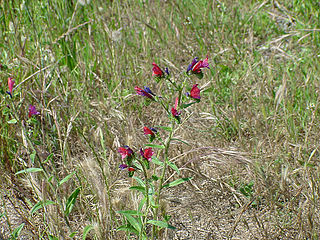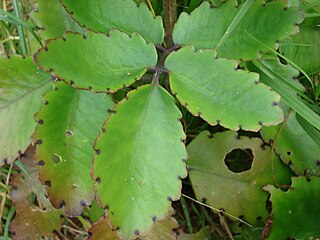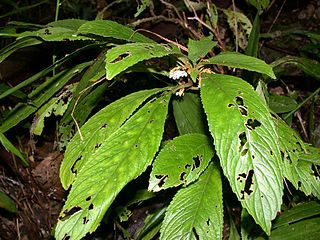
Hypericum calycinum is a species of prostrate or low-growing shrub in the flowering plant family Hypericaceae. Widely cultivated for its large yellow flowers, its names as a garden plant include Rose-of-Sharon in Britain and Australia, and Aaron's beard, great St-John's wort, creeping St. John's wort and Jerusalem star. Grown in Mediterranean climates, widely spread in the Strandja Mountains along the Bulgarian and Turkish Black Sea coast, and also in Flanders in Belgium.

Aaron's beard may refer to the following plants having numerous stamens or threadlike runners:

Glaucium is a genus of about 25 species of annual, biennial or perennial herbaceous flowering plants in the family Papaveraceae, native to Europe, north Africa, and southwest and central Asia. The species commonly occur in saline habitats, including coasts and salt pans.

Sesamum is a genus of about 20 species in the flowering plant family Pedaliaceae. The plants are annual or perennial herbs with edible seeds. The best-known member of the genus is sesame, Sesamum indicum, the source of sesame seeds. The species are primarily African, with some species occurring in India, Sri Lanka, and China. The origin of S. indicum is uncertain, as it is widely cultivated and naturalized in tropical regions. The genus is closely related to the strictly African genus Ceratotheca and is itself probably African in origin.

Adenochlaena is a genus of plant of the family Euphorbiaceae first described as a genus in 1858. It is native to certain islands in the Indian Ocean.
- Adenochlaena leucocephalaBaill. - Madagascar, Comoros
- Adenochlaena zeylanica(Baill.) Thwaites - Sri Lanka

Halimium is a genus of 12 species of evergreen or semi-evergreen subshrubs in the family Cistaceae, closely related to Cistus. They are native to Europe, North Africa and Asia Minor, with the centre of diversity in the western Mediterranean region.

Vaccinium reticulatum, known as ʻōhelo ʻai in Hawaiian, is a species of flowering plant in the heather family, Ericaceae, that is endemic to Hawaii. It grows at altitudes of 640–3,700 m (2,100–12,140 ft) on lava flows and freshly disturbed volcanic ash on Maui and Hawaiʻi, and less commonly on Kauaʻi, Oʻahu, and Molokaʻi. Adaptations to volcanic activity include the ability to survive ash falls of over 25 cm (9.8 in) depth.

Echium creticum, Cretan viper's bugloss, is an ornamental plant.
Canarium fuscocalycinum is a tree of Borneo in the incense tree family Burseraceae. The specific epithet fuscocalycinum is from the Latin meaning "dark calyx".
Koilodepas calycinum is a species of plant in the family Euphorbiaceae. It is endemic to Tamil Nadu in India.

Kalanchoe pinnata, formerly known as Bryophyllum pinnatum, also known as the air plant, cathedral bells, life plant, miracle leaf, and Goethe plant is a succulent plant native to Madagascar, which is a popular houseplant and has become naturalized in tropical and subtropical areas. It is distinctive for the profusion of miniature plantlets that form on the margins of its leaves, a trait it has in common with some other members of Bryophyllum.

Coleonema is a genus of flowering plants in the family Rutaceae. The eight known species are all from the western Cape Province of South Africa. In Australia, where they are cultivated as garden ornamentals, they are often referred to as Diosma.
Brachystemma calycinum is a species of plant native to southwestern China. It is the only species in the genus Brachystemma

Microloma sagittatum, the bokhoring, is a species of plant in the family Apocynaceae, that is native to the south-western Cape, South Africa.
Antirrhinum calycinum is a species of flowering plants.

Ceratostema is a genus of shrubs or dwarf shrubs and lianas in the heath family (Ericaceae)

Hawaiian Vaccinium (blueberries) is a monophyletic group comprising three species endemic to the archipelago of Hawaii: Vaccinium reticulatum, Vaccinium dentatum and Vaccinium calycinum, commonly known in Hawaii as ʻōhelo. While Vaccinium as a larger group is characterized by an inferior ovary and brightly-colored berries that are indehiscent, the Hawaiian group has traditionally been distinguished as having uniquely well-developed calyx lobes and longer calyx tube depth, more cylindrical corolla shape, reduced or absent staminal awns, longer pedicel length, and — compared with temperate relatives — much longer leaf persistence. They are terrestrial or epiphytic shrubs, typically 1 - 6 feet in height, occasionally up to 10 feet, ranging widely throughout the Hawaiian islands over relatively high elevation. The three species thrive in many plant communities, except for Vaccinium reticulatum, which tends to thrive around lava flows, yet is not limited to them. Within the group, distinct taxa vary in berry color, bloom color, foliage shape and size, and pedicel length. Vaccinium reticulatum and Vaccinium dentatum are evergreen, while Vaccinium calycinum is deciduous. All three species tend to fruit and flower throughout the year, but maximum flower and fruit production generally occurs during May - July. Outcrossing between all three species has been successful, and many hybrids have been described. All three species are also capable of selfing, but resulting seed viability differs throughout the species complex.

Rhynchotechum is a genus of plants in the family Gesneriaceae and tribe Cyrtandreae. Species distribution records are mostly from India, Sri Lanka, China through to southern Japan, Indo-China and Malesia through to New Guinea.
Growing as a shrub, Daphniphyllum calycinum is a species in the family Daphniphyllaceae. It is found in northern Vietnam and Southeastern Zhōngguó/China. It is used in biodiesel and in lubrication, soap-making and Chinese medicine.














